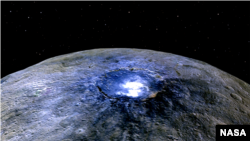The U.S. space agency NASA says it has uncovered some “well-kept secrets” behind the mysterious bright spots on the dwarf planet Ceres.
Ceres, which orbits the sun between Mars and Jupiter, has more than 130 bright spots, most located near impact craters.
Using data from NASA’s Dawn spacecraft, scientists believe they are caused by “a kind of salt.”
The spots, researchers say, were likely caused when asteroids unearthed a mixture of ice and salt.
"The global nature of Ceres' bright spots suggests that this world has a subsurface layer that contains briny water-ice," said Andreas Nathues at Max Planck Institute for Solar System Research, Göttingen, Germany.
Researchers said the inside of one crater, Occator, which contains the brightest spot, reflects about 50 percent of the sunlight that hits it. This is in contrast to the rest of the planet which is “similar in brightness to fresh asphalt.”
The crater is 90 kilometers in diameter and appears to be one of the younger craters on Ceres--about 78 million years old.
Researchers noted that in some views of Occator there appears to be a “diffuse haze near the surface that fills the floor of the crater.” This could be associated with a 2014 observation of water vapor on the Ceres.
In another study using data from Dawn, researchers say there is evidence of ammonium-rich clays on Ceres.
While ammonia alone would evaporate, the detection of it means it may be chemically bonded to other minerals.
More importantly, the presence of ammoniated compounds could mean that Ceres did not “originate in the main asteroid belt between Mars and Jupiter” but rather could have formed in the outer solar system or formed from materials that originated in the outer solar system.
The Dawn probe is now in its final orbital altitude of 385 kilometers and will begin collecting more information about the dwarf planet.
Both studies were published in the journal Nature.
Watch a video about Ceres:









